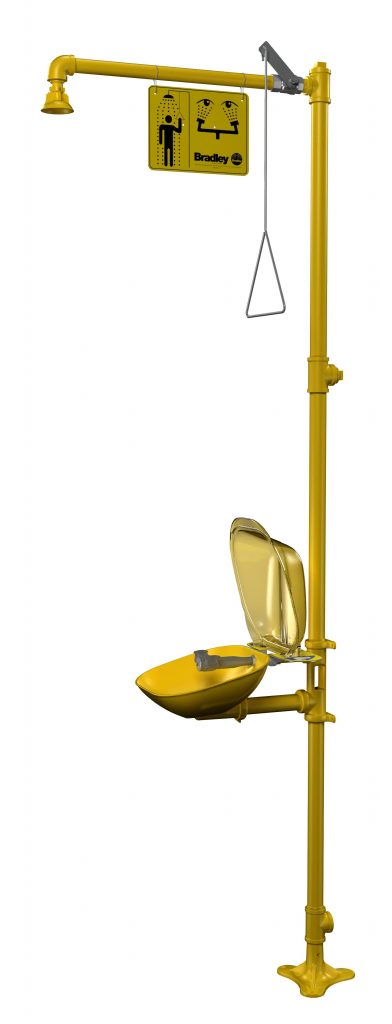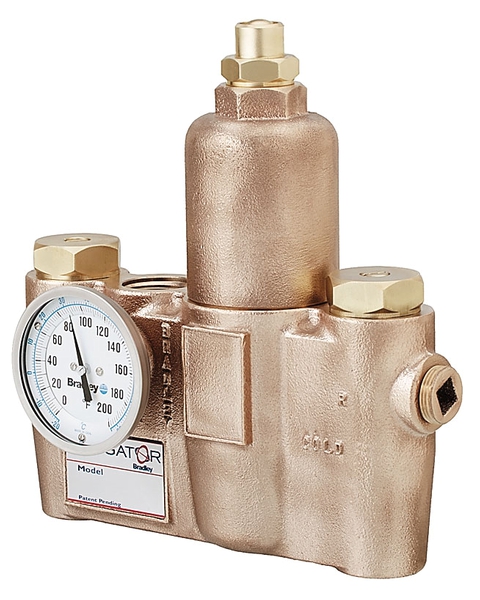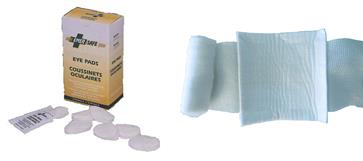Article to come
This is the appropriate shower model for worst-case scenarios. It combines a shower to rinse the body and an eyewash or eye-and-face shower. The combined shower with eye and face wash is certainly the most complete model available. The combined model allows the eyes and body to be rinsed simultaneously or alternately. This type of equipment is often found in areas where chemicals are handled.
Here is a short list of models available with eye wash or face wash.
Combined body showers and eyewash basin (PD19314PDC).

Combined body shower with eyewash station and hand wash hose (PD19314P).

Combined body shower with eyewash basin and stainless-steel bowl (PD19314DC).

Combined body shower with eyes and face wash (PD19314PDCFW).

Combined body shower with pedal eyes and face wash (PD19314AC).

Wheelchair-accessible body, eyes and face shower with steel cover (PD19314DCBF).

Every year several thousand workers suffer eye accidents or skin burns in Canada. The ideal, of course, is to prevent them with safety glasses or face shields, despite all these good intentions, an accident can happen so quickly. The nature of the injury caused by a particle or chemical splash requires different emergency treatment. That is why combination showers are an essential complementary measure to reduce the consequences of chemical exposure.
Prompt and well-done interventions minimize the after-effects on victims. The presence of combination showers in strategic locations, their accessibility, and their proper functioning are all factors that reduce the severity of injuries. The number of showers must also be evaluated in the event that more than one worker is injured at the same time.
Do you have workers who work in isolated areas or who are alone? In such a case, the addition of an alarm system on the combination shower is essential. This is the only way to alert the first responders and assist the victim quickly.

There may be several places in a company where combination showers are required, without being exhaustive here is a short list taken from our many visits to industries;
Laboratories.
Storage and use areas for controlled products.
Areas where workers are exposed to dust.
Areas where workers are exposed to dust. Forklift truck battery recharging areas.
Production areas where chemicals are transferred.
Areas where spraying operations are carried out.
Areas where dipping operations are carried out.
Storage areas for flammable liquids, inks or other chemicals.
And other…
Ground rules.
These devices are emergency equipment. So, they must be accessible at all times. In addition, only one action must be taken to activate it. This device must be easily activated by the victim and remain in function without the victim having to keep his hand on the activation system.
Water supply lines should provide sufficient flow. The special feature of this type of shower is that the flow rate must take into account the simultaneous use of the body part and the eye part. Therefore, it requires a large water flow. The addition of a regulation thermostatic valve is necessary. The water must remain at a warm temperature for the entire duration of the rinse. The minimum duration varies according to the aggressor product. Therefore, it is important to ensure that there will be no lack of hot water during periods of frost. In Canada, January and February are often the coldest months of the year.
With water that is too cold to rinse your eyes and with too hot a temperature you risk aggravating your injury.
Recommendation for the location of the combination shower.
The combination shower must be accessible to workers in less than 10 seconds. In addition, the distance between the risk area and the shower must not exceed 30 metres. It is recommended that the showers be 3 to 6 metres (10 to 20 feet) closer in the case of highly corrosive liquids. Preferably install them near traffic lanes or near emergency exits. They will be easier to spot than if the shower is installed in a remote corner of your business where no one has ever ventured.
Ensure a safe clearance around the edges of combination showers. When these showers are in operation, they can generate large splashes of water. Therefore, make sure there are no electrical cords lining the floor or electrical equipment nearby. In addition, the victim should not be electrocuted.
Choosing a shower location in a temperate zone remains an essential objective. The same applies to all water supply lines. Every effort should be made to avoid temperature variations or temperature losses caused by long distances. Remember to install the hot water tank as close as possible to the shower, as heat loss will be less in winter. Make sure that there is no risk of frost throughout the entire installation. Be aware that combined showers are also available in areas where there is a risk of freezing, but they are obviously more expensive.
Don’t forget to add signage and make sure it is visible from everywhere. You can obtain this type of signage from Sylprotec. Visit the posters section of their website, the ECU504 poster or the OSHA EOS405 model.
A thermostatic valve (mixing valve) is an indispensable device for controlling water temperature. Especially in Canada because of the cold winter temperatures. The valve is pre-set to supply water at 29°C (85°F). The thermostatic valve keeps the water at an adequate temperature. The rinse water should be neither too cold (to allow the eyes to be rinsed comfortably for the minimum time required) nor too hot (to avoid aggravating eyes or facial injuries and to prevent accidental burns).
This valve works with a liquid thermostat and is a single valve. It includes a safety shutoff mechanism that will automatically shut off the hot water supply in the event that the cold-water supply fails, to prevent burns. A cold-water bypass mechanism ensures a constant flow of cold water at all times.
Why buy a regulation thermostatic valve.
Some people who see the price of regulatory valves will have the reflex to want to replace it with a model used for regular showers. This is a very bad initiative! If the cost of regulating valves is high, it is because of their characteristics.
– The valve properly mixes the water temperature.
– The valve stops the flow if the temperature is too hot.
– The valve lets the water flow if the water temperature is too cold.
Unfortunately, there is no bypass, so not putting anything in either make the shower non-functional. The suggested mixer model is: the PD192100 for combination showers.

Caring for your combination shower.
It is recommended to purge the standing water from the combined shower pipes once a week. This will avoid rinsing the body or eyes or rinsing with water contaminated with microorganisms, limescale or rust. We recommend implementing a small inspection procedure during which a person in charge will have to activate the shower for 1 to 3 minutes, check the water temperature, the quality of the water jets, write on an inspection card the date of the inspection and finally check the clearance around the shower.
Rinse time.
According to the American standard AINSI Z358.1-2009, the rinse time must be at least 15 minutes. It is not uncommon to find this same recommendation on chemical MSDS in the first aid section. However, when a medical authority publishes an opinion on the matter, it must be taken into account.
The Montreal-Centre regional health and social services board has published an advisory on changing the flushing time for burns.
In cases of skin burns, the flushing time increases to 20 minutes for thermal burns and increases to 30 minutes for chemical burns.
For eye burns, the flushing time increases to 20 minutes for thermal burns (flash glare) and up to 30 minutes for chemical burns. This corresponds quite often to the case associated with the use of eye showers.
“The Canadian regulation on its site (http://.cchst.ca/) specifies and goes a little further to know :
A 5-minute rinse for accidents involving a non-irritating or slightly irritating chemical.
A 15 to 20-minute rinse for accidents involving a chemical product that causes moderate to severe irritation and also for a chemical product that can cause acute toxicity if absorbed through the skin.
A rinse lasting 30 minutes for accidents involving corrosive products, which is identical to the recommendations of the Montreal-Centre regional health and social services board.
It adds, a 60-minute rinse for accidents involving strong alkali (e.g. sodium hydroxide, potassium hydroxide or calcium hydroxide).”
Minimum recommended flow rate.
The eyewash station should have a minimum flow rate of 0.4 GPM (1.5 L/min) at 30 PSI.
Body wash must have a minimum flow rate of 20 GPM (76 L/min) at 30 PSI.
Basic rules to be followed when burning.
Bring victims fully clothed to the shower.
Have him/her remove these clothes, being careful not to reach other parts of the body with the contaminated clothing. Protect his eyes and face.
Ask the victim to remove contact lenses, if present.
Remove powdered chemicals with a compress before rinsing.
Assist the victim until the recommended flushing time has elapsed.
After rinsing the body
Put sterile gauze, preferably of the non-adherent type, on the wounds. Such as PS319, PS320 and PS306.

If large areas are involved, cover the body parts with a clean sterile sheet.

Make a copy of the MSDS for the chemical to the paramedics who will pass it on to the doctor.
Basic rules to be followed in an eye accident.
Ask the victim to remove contact lenses, if they have any.
The victim should open his or her eyelids with these fingers to keep the eyes open.
Ask the victim to rotate these eyeballs slightly to rinse thoroughly and dilute the chemical attacker.
Avoid splashing liquid into the other eye if only one eye is involved.
Ask the victim to lift these eyelids several times to ensure that they are rinsed as thoroughly as possible.
Continue rinsing to the recommended minimum.
After rinsing the eyes.
Cover one or both eyes with a non-adherent pressure dressing (PS514). You can add a non-adherent pressure dressing (PS319) to hold it in place.

Another approach is to continue rinsing with portable solutions during transport to the hospital, such as PD505 or PD520B. This may be a good option if the hospital is far from the accident site.

Make a copy of the MSDS for the chemical to the ambulance attendants who will pass it on to the doctor.
Legislation
Excerpts from the Regulation respecting occupational health and safety (RSST) of the province of Quebec in Canada.
«75. Emergency equipment: Eye showers or safety showers must be made available to workers in the following cases:
1- when a corrosive or other hazardous material is likely to cause rapid, serious or irreversible damage to the skin or eyes of workers:
2- when a toxic material is likely to be quickly absorbed through the skin or eyes or cause severe irritation.
In other cases, equipment for rinsing the eyes or washing the skin, such as showers, portable showers, eye rinser or any other taps, must be made available to workers, depending on the nature of the hazards to which they are exposed.
76. Installation of showers: The eye showers and emergency showers referred to in the first paragraph of Article 75 must be clearly identified and easily accessible. In addition, they must be within immediate reach of exposed workers and be supplied with warm water.
The water in showers supplied by a drinking water system and the water supplied to portable showers must be changed regularly to ensure that it is safe.
(RROHS,S-2.1, r 1901)
Eye showers and safety equipment are available at Sylprotec. You can buy online or at their Saint-Leonard store. You’ll also find a wide selection of first aid kits, fire protection equipment and more.
Sylvain Patrice f.p.t.
By the same author:
Presentation of the eyewash model PD19224PDC.
Sylprotec’s kit no. 4 is an easy choice.
Regulation respecting minimum standards of first aid and first aid.
Safety clothing, its designs and materials.
The codex of coated knitting gloves.
